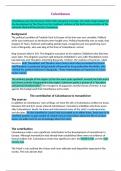Summary
Summary Columbanus and his controversies
- Course
- Institution
- Book
This document provides a summary of notes needed for the CCEA Religious Studies A2 Unit 5 Celtic exam; specifically on everything you need to know about Columbanus' character and the controversies he was involved in
[Show more]




